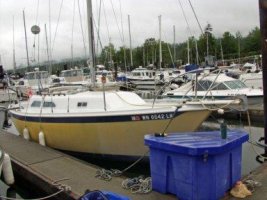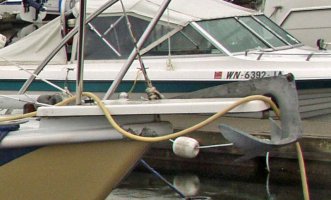Anchor Tests
I wouldn't rely on anchor test results for buying an anchor. Of course, I'm a fan of Bruce anchors which never do well.
Just look at the bow rollers of serious cruisers and you'll see that Bruce, CQR and Delta are the most common primary anchors by far. They need to be heavy though and backed with lots of chain.
In my experience, the folks that drag, tend to do so at night, in windy conditions and better than half the time they relied on a Danforth type anchor without enough chain. When the wind/current switched on them, the anchor broke out and then failed to reset. The plow types like Bruce, CQR and Delta don't usually pull out during such shifts but tend to screw themselves into the bottom. This was illustrated for me one day when I swam the anchor after a very shifty night and saw the chain pattern in the sand. The anchor chain had scribed a nice level 270 degree partial-circle maybe 100 feet in diameter around the anchor. The anchor which had 2 of 3 flukes buried when set the night before (typical Bruce set) was completely out of sight under the sand.
In Georgetown, the boats that drag most often tend to be the ones anchored very close together in an area right off the hub of cruiser activities well known as 'Teflon Alley' because of the poor holding. These boats often anchor with multiple anchors (that foul each other), short scope and in my opinion, way too close to other boats. When storms and squalls move through, the VHF can provide an evening's entertainment, listening to all the bitchin' and hollerin'.
Rather than keep anchor watches (which we'll do if conditions get bad enough) we set the anchor alarm on the GPS. However, we find that we get lots of false alarms mostly because the boat has swung around with a wind or current shift. What I really like is an anchorage with lots of room around me to were I can set the anchor alarm to 300-400 feet ... then I don't get the false alarms. Anchor watches shouldn't be necessary if your gear is big enough and it's set properly. We watch for the other guys when the wind pipes up.
On the technique side, we almost always lay out all 100ft of chain plus 10 to 25 feet of nylon with chafing gear over the bow roller regardless of depth up to about 20ft of water. Anchor chain in the well can't help hold the boat. If the water is deeper, we give more nylon. I prefer at least 7:1 scope and more is better. We seldom anchor in over 15 ft of water anyway and we try to give other boats as much room as possible. We also back down enough to straighten the chain then apply full power slowly to set the hook, all the while feeling the rode for the vibration that the anchor makes when it bounces over the bottom. Then we usually use the look bucket or dive the anchor to get a look at the set. In my experience, trying to set an anchor by hand is an exercise in futility. The engine does it better.
We find that our E38 doesn't swing any more or less than everyone else. Trawlers and catamarans swing somewhat faster and heavier boats seem to swing more slowly but eventually it all works out the same. About the only time we see boats lying every which way is when there's zero wind. I have also noticed that boats with riding sails seem to swing just as much although they swing faster when the wind catches the sail and slower as the sail stalls and shifts.





